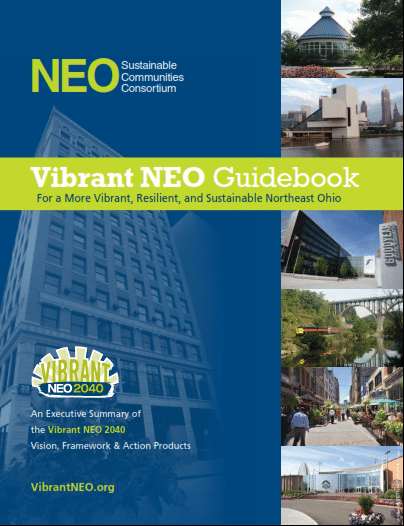VIBRANTNEO 2040
A VISION AND FRAMEWORK FOR THE FUTURE OF NORTHEAST OHIO






FULL REPORT NOW AVAILABLE
WATCH VIBRANT NEO: A VISION AND FRAMEWORK FOR THE FUTURE OF NORTHEAST OHIO
THE VIBRANT NEO GUIDEBOOK
We have developed an executive summary of the Vision, Framework and Action Products. The Vibrant NEO Guidebook describes the Process, Objectives, Recommendations, Priority Initiatives and Indicators. The document include maps of each of the major vision themes and summaries of the Action Products.
LATEST NEWS FROM THE BLOG
AMATS, the Akron Metropolitan Area Transportation Study, is one of the four Metropolitan Planning Organizations involved in Vibrant NEO 2040 that we discussed in our post last week. One of their many initiatives is the Connecting Communities program which “is designed to provide communities with funding to develop transportation plans that will lead to the identification of projects eligible for AMATS funds.” The Connecting Communities grant program was a recommendation from AMATS’s Connecting Communities Planning Initiative (link is to a large pdf file) in 2010. The purpose of Connecting Communities – A Guide to Integrating Land Use and Transportation is to promote a region that balances environmental, social and economic concerns by improving coordination between land use and transportation. Connecting Communities utilizes a regional planning process to explore strategies to increase transportation choices and accessibility, help communities make collaborative, informed decisions to coordinate development, reduce environmental impacts and improve regional connectivity….
As a partner, supporter and/or member of NEOSCC, you have likely heard us mention our new Conditions and Trends Platform (CAT), an online tool designed to help Northeast Ohioans understand, talk about and contribute to the future of our region. We are very excited about the potential of this tool, and we need your help to make sure it gets seen and shared. We are relying on you and your fellow NEOSCC supporters to help spread the word about the Conditions and Trends platform to your colleagues, friends and family across the region. We’ve made it easy for you; in the attached Toolkit, you will find several components designed to help you talk about and share the Conditions and Trends Platform with your networks, in person and especially online. Conditions and Trends Toolkit: What It Is and How to Use It NEOSCC’s Conditions and Trends Platform (CAT)…
A significant component of NEOSCC’s leadership are the four Metropolitan Planning Organizations in Northeast Ohio. What is a Metropolitan Planning Organization? You can find out in the following presentation – NEOSCC_Overview_101_What is an MPO. Here is some quick background: NEOSCC and the Vibrant NEO 2040 planning process includes the following MPO’s and their county jurisdictions: Akron Metropolitan Area Transportation Study (AMATS) – Portage and Summit Counties Eastgate Regional Council of Governments – Mahoning and Trumbull Counties Northeast Ohio Area Coordinating Area (NOACA) – Cuyahoga, Geauga, Lake, Lorain, and Medina Counties Stark County Regional Planning Commission and the Stark County Area Transportation Study (SCATS) – Stark County The two other counties Ashtabula and Wayne County that are part of the Vibrant NEO 2040 effort are covered through Councils of Governments. This is a topic that will be covered soon in the Vibrant Daily. As part of their planning process, the MPO’s…




